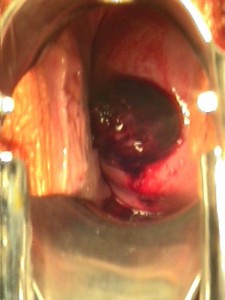With an incomplete abortion, some tissue remains behind inside the uterus.
These patients typically present with continuing bleeding, sometimes very heavy, and sporadic passing of small pieces of pregnancy tissue.

Ultrasound may reveal the presence of identifiable tissue within the uterus. Serial quantitative HCG levels can be measured if there is doubt about the completeness of a miscarriage.
Left alone, many of these cases of incomplete abortion will eventually resolve spontaneously, but so long as there are non-viable pieces of tissue inside the uterus, the risks of bleeding and infection continue.
Treatment consists of converting an incomplete abortion into a complete abortion. Usually, this is done with a D&C (dilatation and curettage). This minor operation can be performed under local anesthesia and takes just a few minutes.
Alternatively, bedrest and oxytocin, 20 units (1 amp) in 1 Liter of any crystalloid IV fluid at 125 cc/hour may help the uterus contract and expel the remainder of the pregnancy tissue, converting the incomplete abortion to a complete abortion.
Alternatively, ergonovine 0.2 mg P.O. or IM three times daily for a few days may be effective.
If fever is present, broad-spectrum antibiotics are wise.
Rhogam is given to rH negative women.
Any tissue fragments visibly protruding from the cervical os can be grasped with a ring or dressing forceps and gently pulled straight out. This simple and safe procedure will have a beneficial effect on the bleeding.
